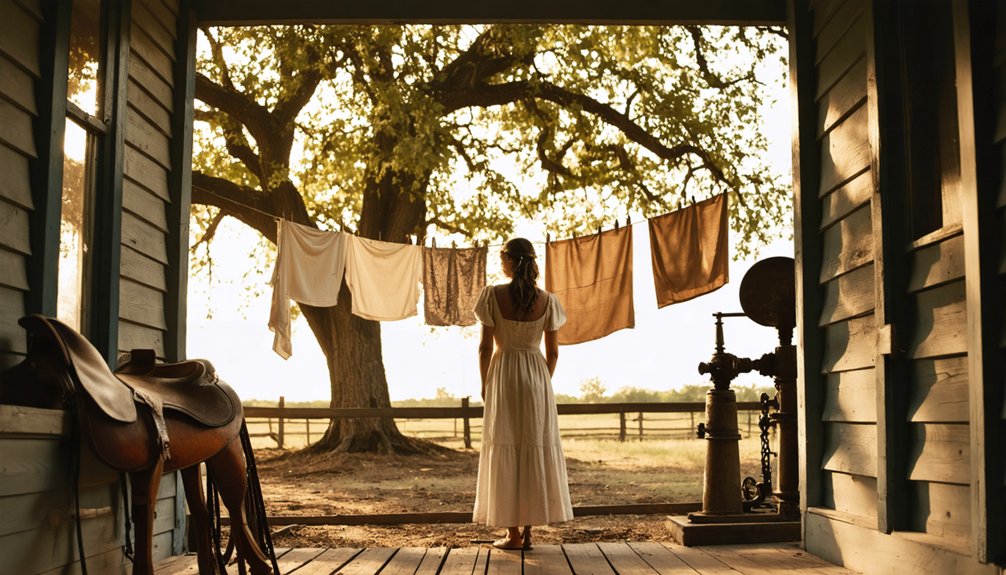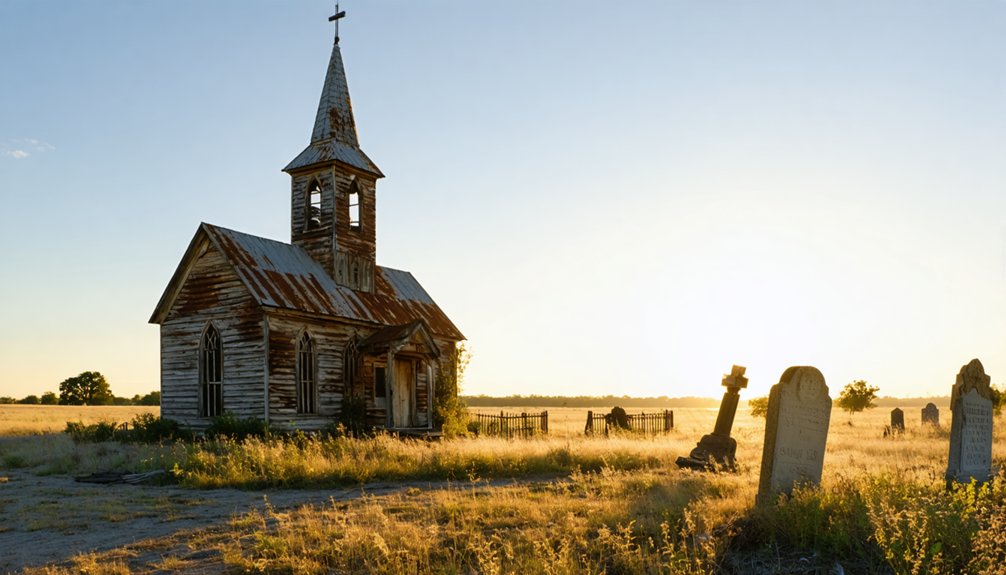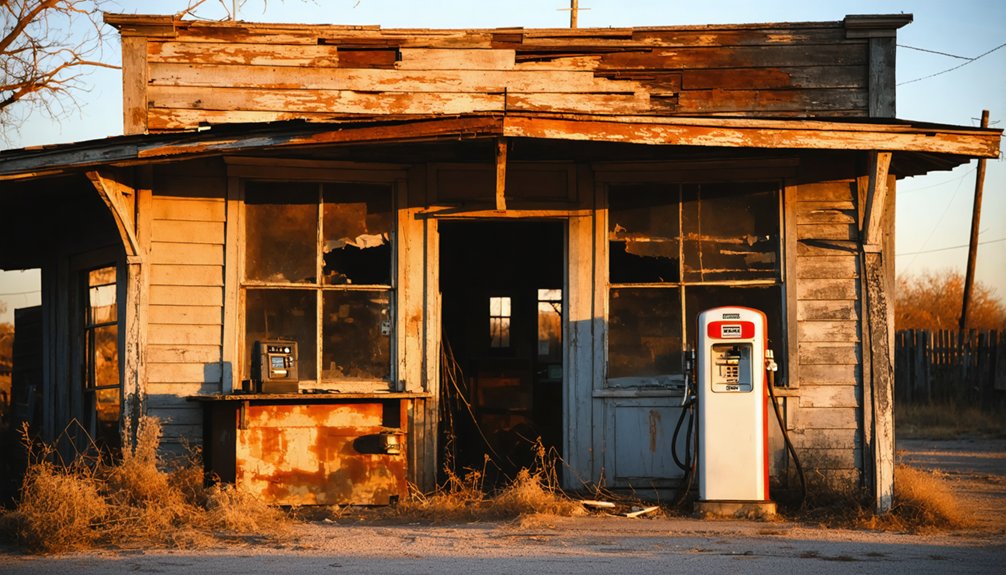You’ll find Candlish, Texas, eleven miles east of Beeville, established in 1909 along Medio and Blanco creeks. This agricultural settlement initially thrived with a dozen businesses, including a hotel and steam mill, after its 1885 incorporation. The town’s promising start faltered when major railroad lines bypassed it, leading to economic decline and eventual abandonment. Today, only scattered foundations and oral histories preserve the legacy of this lost Texas community, with deeper stories waiting in the shadows.
Key Takeaways
- Candlish, Texas was established in 1909 along Medio and Blanco creeks, eleven miles east of Beeville, functioning as an agricultural settlement.
- The town flourished briefly after its 1885 incorporation, boasting twelve businesses including a hotel, livery stable, and steam mill.
- Railroad development initially boosted the town in 1907, but later shifts to road transportation contributed to its eventual decline.
- Economic isolation occurred when major railroad lines bypassed Candlish, leading to the loss of essential services and population decline.
- Only deteriorating foundations and scattered rubble remain on private property, with the town’s history preserved mainly through oral accounts.
A Town Born by the Creek
While many Texas towns emerged near railroads or crossroads, Candlish established its roots along the crucial waterways of Medio and Blanco creeks in 1909.
You’ll find this ghost town eleven miles east of Beeville, where the creek culture shaped the development of several communities, including Medio Hill, Robinson, and Cummingsville.
The town’s agricultural heritage flourished thanks to the fertile prairie lands surrounding these crucial waterways.
Like Lake Creek Settlement, early settlers received land grants near waterways that were vital to establishing successful communities.
You can trace Candlish’s brief but significant history through its general store, hotel, and school, which served the needs of local settlers and farmers.
The creek-fed landscape supported diverse livelihoods, from farming to stockraising and freighting.
Early Spanish padres and soldiers traveled through this area on ox-cart roads, marking some of the earliest documented passages through the region.
Even today, fossil beds discovered near these creeks in the late 1930s remind you of the region’s rich geological past.
Early Life and Settlement
You’ll find the earliest traces of Candlish’s settlement near Medio Creek, where pioneer families strategically established their homes to secure reliable water access in the 1850s.
The town’s first infrastructure emerged as settlers constructed basic wooden buildings, including a general store that served as both a commercial and social hub for the growing community. Similar to wagon route settlements like Cannonville, the location proved advantageous for early trade and transportation. Like the historic Milton Favor ranch in West Texas, early settlers recognized the potential for establishing successful ranching operations in the region.
While farming and small-scale ranching sustained the initial population, the town’s founders worked to establish the fundamental elements of community life typical of Texas Hill Country settlements.
Founding Near Medio Creek
Three pioneer communities laid the foundation for what would become Candlish, Texas, establishing themselves near Medio Creek around the turn of the 20th century.
You’ll find that these early settlers chose their locations strategically, positioning themselves along the creek’s essential water source to support pioneer agriculture and sustain their growing homesteads.
The area’s rich creek ecosystems offered more than just water – they’d discover million-year-old mastodon fossils in the 1930s, highlighting the region’s ancient significance.
When developers formally laid out the townsite in 1907, they built upon the existing framework these hardy pioneers had established.
The settlers faced typical frontier challenges, but their proximity to Beeville and access to Medio and Blanco Creeks provided critical resources for survival in the South Texas wilderness.
Like the ill-fated town of Indianola, Texas, which was destroyed by hurricanes in the 1800s, Candlish would eventually fade into history.
By 1909, the growing settlement included a hotel and store, becoming a hub for local commerce and traveler accommodations.
Town’s First Infrastructure
As Candlish emerged from its pioneer roots in 1907, the town’s first infrastructure reflected both careful planning and industrial influence.
You’d have found a thoughtfully designed settlement just north of the railroad tracks, where early utilities included electricity, indoor plumbing, and a water treatment plant. The town’s crucial civic structures featured a fire station and post office, constructed with locally produced bricks from the town’s clay plant.
The settlement’s controlled nature was evident in its distinctive flat metal barbed wire fencing, with guards monitoring access points to regulate entry. Much like the nearby town of Mingus that attracted ten whiskey joints, Candlish drew workers seeking entertainment and socialization. Workers were required to use company store scrip for all purchases within the town.
This infrastructure supported a self-contained community, while railroad spur lines connected Candlish to surrounding coal mines and main rail arteries, establishing critical economic lifelines that would shape the town’s development.
The Rise and Fall of Local Commerce
While many Texas towns emerged organically, Candlish’s commercial identity began deliberately in 1872 when William Jernigin and Josiah Hart Jackson established a strategic mercantile store near the South Sulphur River.
The community’s evolution accelerated as their store attracted additional businesses, and by 1885, you’d have found 12 enterprises, including a hotel, livery stable, and steam mill. The town’s early success led to its formal incorporation that same year.
The arrival of the St. Louis Southwestern Railway in 1887 and Texas Midland Railroad in the 1890s transformed Candlish into a bustling trade hub. Much like Commerce, Texas, the town prospered from surrounding cotton fields and agricultural activities.
However, the town’s commerce decline became inevitable as railway services diminished and larger urban centers drew away business.
Despite the 1939 discovery of fossil beds nearby, the reduced commercial activity and population loss led to the community’s eventual abandonment by mid-20th century.
Transportation’s Impact on Destiny
Transportation infrastructure shaped Candlish’s rise and ultimate demise, with the railroad serving as both creator and destroyer of the town’s fortunes.
You’ll find Candlish’s story mirrors many Texas towns where transportation trends dictated survival. When the railroad arrived in 1907, it brought promise and prosperity, positioning the settlement north of the tracks for ideal access.
However, economic shifts would later challenge Candlish’s existence. As Texas evolved from rail to road transport, towns without highway connections struggled.
The rise of Texas State Highway 36 and declining rail freight services transformed rural demographics. You can trace Candlish’s decline through these changing patterns, where mechanized farming and improved roadways drew people away.
The town’s fate was sealed by its inability to adapt to new transportation realities, proving that accessibility often determines a community’s destiny.
Daily Life in Early Candlish

Life in early Candlish revolved around the demanding coal mining industry, which attracted a diverse workforce of immigrant laborers from Italy, Poland, Britain, and Ireland.
You’d find these workers living in company-controlled housing near the mines, where their daily routines centered on extractive labor and skilled trades like brick masonry.
Immigrant contributions shaped the town’s character through their cultural traditions and work ethic.
The diverse cultural fabric of the town was woven from immigrant values, forever shaping its identity and communal spirit.
While company restrictions limited movement with barbed wire fencing and strict access control, residents fostered strong communal traditions within these confines.
You’d witness shared experiences in public spaces like cemeteries, where headstones marked the town’s multicultural heritage.
Despite the regulated environment, workers maintained their ethnic customs and religious practices, creating a close-knit community bound by their shared mining life and cultural backgrounds.
The Path to Abandonment
The gradual decline of Candlish began when major railroad lines bypassed the town in favor of larger settlements like Stinnett.
You’d have witnessed the town’s subsequent economic isolation as transportation routes diverted commerce and settlers elsewhere, leaving Candlish increasingly disconnected from regional growth.
The community decline accelerated as essential services began to disappear.
Without a sustainable economic base or strong political standing, you’d have seen schools, markets, and the post office close their doors.
Natural challenges, including harsh weather and limited water resources, made agricultural success difficult.
The town’s remaining population couldn’t maintain the aging infrastructure, and buildings fell into disrepair.
As job opportunities dwindled, families moved to nearby towns with stronger economies, ultimately leaving Candlish to fade into a ghost town.
Historical Echoes and Remains

Modern visitors searching for Candlish will find few tangible remnants of this once-hopeful Texas settlement. The site, now on private property, holds only deteriorating foundations and scattered rubble where frontier-era wooden and brick buildings once stood.
You’ll find no historical markers or tourist signage to guide your way through these abandoned dreams.
While ghostly legends and folklore echo through local histories, they’re sparsely documented compared to other Texas ghost towns. The town’s physical traces persist mainly in old roadbeds and altered landscapes from early ranching activities.
What remains exists primarily in county records, rare photographs in historical archives, and oral histories passed down through generations of area residents, preserving fleeting glimpses of Candlish’s brief existence on the Texas plains.
Frequently Asked Questions
Were There Any Notable Crimes or Lawlessness in Candlish’s History?
You won’t find documented crime incidents in available records. While law enforcement likely existed in this mining town of 10,000 people, specific cases of lawlessness aren’t historically preserved.
What Native American Tribes Originally Inhabited the Candlish Area?
As you walk where warriors once roamed, you’ll find the Comanches dominated Candlish’s territory, though Tonkawa and Apache tribal influence was significant in these historical settlements before European expansion.
Did Any Famous Historical Figures Ever Visit or Stay in Candlish?
You won’t find any famous visitors or historical legends associated with this location – historical records don’t show evidence of any notable figures ever staying or visiting the settlement.
What Was the Highest Recorded Population of Candlish During Its Peak?
While you’d probably like a precise number, historical records haven’t preserved Candlish’s exact peak population. Based on population trends of similar Texas mining towns, it likely peaked at several hundred residents.
Were There Any Churches or Cemeteries Established in Candlish?
Like shadows cast by an unbuilt church steeple, you won’t find documented evidence of any church architecture or cemetery legends in this settlement, though similar towns typically had these sacred spaces.
References
- https://atlas.thc.texas.gov/Details/5025003315
- https://mix941kmxj.com/the-strange-sad-story-of-a-texas-ghost-town-youll-never-visit/
- https://www.youtube.com/watch?v=bbVM_-giQIE
- https://texashighways.com/travel-news/four-texas-ghost-towns/
- https://www.youtube.com/watch?v=phjUE19A8HM
- https://www.ghostsandgetaways.com/ghost-towns
- https://en.wikipedia.org/wiki/List_of_ghost_towns_in_Texas
- https://www.texasescapes.com/Texas-Ghost-Towns-A-to-Z.htm
- https://www.tshaonline.org/handbook/entries/lake-creek-settlement
- https://www.forttours.com/pages/hmbee.asp



